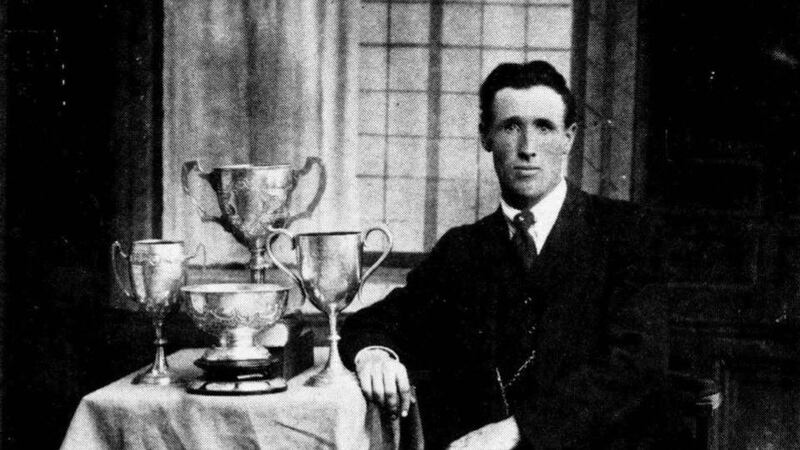Thomas Courtney had an interesting job during the War of Independence. He worked in an obscure branch of the post office known as “the steaming and opening department”. This wasn’t an officially recognised position, mind. He was actually a telegraph boy in the post office, but this made him perfectly placed to intercept military correspondence and pass on valuable intelligence to his companions in the IRA.
My grandad was intelligence officer in the Mid-Galway No 1 Brigade of the IRA, Castlegar Company. His code-name was Captain Puzzle.
He was born in Newcastle in Galway in 1890, and was a member of the Ancient Order of Hibernians and captain of the Temperance Boat Club.

He was a champion rower, winning the Senior Sculls Championship of Ireland in 1920, 1921 and 1923.
He had become politicised as a teenager after stopping to listen to a speech by Arthur Griffith in Eyre Square. Galway was, in his opinion, “the most shoneen town in Ireland”, and he determined to join the armed resistance and battle British influence.
He delivered secret letters between various IRA commanders while on his postal rounds and smuggled messages in to prisoners in Galway jail. On one of his rounds, he was stopped and searched by the Black and Tans in Castlegar, who found republican documents in his post bag. They dragged him off to the notorious Earl’s Island barracks, where he was tortured and threatened with death.
On his release from Earl’s Island, he went on the run – or, as his mother put it, “on your keeping” – and joined the growing numbers of rebels conducting a clandestine war against the British army, the RIC and the Black and Tans.
During 1920, he took part in raids on mail cars, ambushes on RIC vehicles, sniping on Renmore Barracks, and a shootout at Galway Railway Station in which a volunteer, Seán Mulvey, and a Black and Tan named Krumm were killed.
Courtney was even immortalised in song – Verse 5 of The Second Western Division goes something like this:
“Note a man of iron rule
In Brigadier Mick Newell
From ‘16 down he made
A wise provision
With Tom Ruane and Brian Molloy
Tom Courtney was his guide
In the second western division.”
OK, it's not exactly The Soldier's Song , but who's to say it wasn't the Gangnam Style of its day?
Fast-forward more than 40 years to 1963, and local Galway author Walter Macken was beginning work on his new novel, The Scorching Wind , the final part of a trilogy that began with Seek the Fair Land and continued with The Silent People .
As part of his research, Macken interviewed Courtney, among others, about his exploits in the Mid-Galway IRA. One of my grandfather’s stories had just the nail-biting tension Macken needed for his fictional tale.
Grandad was smuggling a wooden suitcase filled with small arms and incendiary devices on the train from Dublin to Galway when two armed Tans came into his carriage and took their seats.
Trying to act naturally, Courtney chatted nonchalantly with the soldiers, praying that they wouldn’t ask to examine his suitcase. But then, as the train journey got underway, one of the Tans suggested playing a game of cards to while away the time, and grabbed the suitcase to use as a table, commenting on its unusually heavy weight.
Granddad told them the case was filled with snooker balls for the Temperance Boat Club. The trio played cards all the way to Galway, the soldiers never guessing that the case of snooker balls was actually packed with guns and explosives. One of the soldiers even helpfully hoisted the suitcase off the train, much to the astonishment of Granddad’s fellow insurgents waiting to meet him.
A copy of The Scorching Wind was always prominently displayed on our dining-room bookshelf in Glenageary. Inside, a typewritten sheet of paper, faded and dog-eared, detailing the page and paragraph numbers of the passages based on my grandfather's IRA stories.
I still remember that sheet of paper, and I still remember Pop Courtney, behatted, thin as a rake, with his small, round John Lennon glasses, his grandchildren gathered around him to listen to his stories of rebellion and derring-do. He died in 1967 aged 77, but some of his stories are preserved on reel-to-reel tapes made by my dad in the 1960s.
My cousin, Thomas Courtney, has pages of testimony my granddad gave to the Bureau of Military History 1913-1921, which was set up by the minister of defence in 1947 to collate material, recollections and eyewitness accounts from the Rising and the War of Independence.
In his account, Granddad recalls the hopeless wait for the arrival of a German submarine which was to bring arms to help the Galway volunteers play their part in the Rising, and the tense weeks following the Rising, when he skulked around Galway and its outlying villages trying to avoid arrest .
He still managed to inflict some damage on the British regime, though, organising a dance to raise money for his imprisoned comrades which the local priest, Fr McHugh, tried to ban, and playing a prank on the local RIC by submitting false army recruitment forms filled in with the names of constables and their friends, resulting in a number of them being called up for duty.
My cousin also has a letter from the taoiseach, Eamon de Valera, dated December 10th, 1939, thanking Granddad and his colleagues in the Mid-Galway No 1 Brigade Old IRA for their offer of national service at the start of the Emergency.
Fast-forward to 2012, and the publication last November of Blood for Blood the Black and Tan War in Galway (Mercier Press, €14.99) by Galway author William Henry. It's a detailed account of the Black and Tans in Galway between 1920 and 1922, and the rebels who stood up to these "thugs in uniform", and with a full account, card game included, of my grandfather's role.





